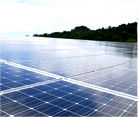|
 Solar photovoltaics offer consumers the ability to generate electricity in a clean, quiet and reliable way. Solar photovoltaic systems are comprised of photovoltaic cells, devices that convert light energy directly into electricity. Because the source of light is usually the sun, they are often called solar cells. The word photovoltaic comes from “photo,” meaning light, and “voltaic,” which refers to producing electricity. Therefore, the photovoltaic process is “producing electricity directly from sunlight.” Photovoltaics are often referred to as PV. Solar photovoltaics offer consumers the ability to generate electricity in a clean, quiet and reliable way. Solar photovoltaic systems are comprised of photovoltaic cells, devices that convert light energy directly into electricity. Because the source of light is usually the sun, they are often called solar cells. The word photovoltaic comes from “photo,” meaning light, and “voltaic,” which refers to producing electricity. Therefore, the photovoltaic process is “producing electricity directly from sunlight.” Photovoltaics are often referred to as PV.
PV cells convert sunlight directly into electricity without creating any air or water pollution. PV cells are made of at least two layers of semiconductor material. One layer has a positive charge, the other negative. When light enters the cell, some of the photons from the light are absorbed by the semiconductor atoms, freeing electrons from the cell’s negative layer to flow through an external circuit and back into the positive layer. This flow of electrons produces electric current. To increase their utility, dozens of individual PV cells are interconnected together in a sealed, weatherproof package called a module. When two modules are wired together in series, their voltage is doubled while the current stays constant. When two modules are wired in parallel, their current is doubled while the voltage stays constant. To achieve the desired voltage and current, modules are wired in series and parallel into what is called a PV array. The flexibility of the modular PV system allows designers to create solar power systems that can meet a wide variety of electrical needs, no matter how large or small.
What do the terms watt (W), kilowatt (kW), and kilowatt-hour (kWh) represent?
A watt (W) is a unit of power. A kilowatt (kW) is a thousand watts and a megawatt (MW) is a million watts. A watt-hour (Wh) is a unit of energy, or power multiplied by time. A kilowatt-hour (kWh) is a thousand watt-hours and a megawatt-hour is a million watt-hours (MWh). The electricity you purchase from the utility is measured in kilowatt-hours (kWh) and 1kWh is termed as 1 unit. Most single-family homes use 20 kWh or more per day. A refrigerator uses 1.2 kWh per day, and a computer uses 2.4 kWh per 8-hour workday.
What is BIPV?
Building Integrated Photovoltaic (BIPV) is the buzz word used to describe multifunctional solar products that generate electricity while serving as construction materials. There is a large variety of BIPV products available in the market today. They are not only flexible in shape but can come in various colours and functions. BIPV can provide benefits and contribute to enhancing the attractiveness (or uniqueness) of a building’s design.
How are BIPV systems used?
BIPV systems can be aesthetically integrated into the building from the initial stages or retrofitted to an existing building. BIPV can be used as a: Roof, Façade, Skylight Atrium, Awning and etc.
Source:
http://www.mbipv.net.my. MBIPV Project, July 2 2011
|